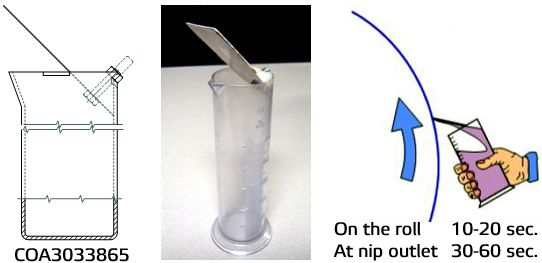Measuring applied and residual coat weight on applicator rolls
Starch and coating is applied to the applicator roll using a rotating rod. The amount of coating applied to the roll is the most important variable for good coat weight control. Rod rotational speed does not affect coat weight applied.
The amount of coating applied to the roll is a function of:
- the type of rod used (grooved or smooth),
- the size of the rod (10, 15, 20, 25 mm),
- the size of the grooves on grooved rods,
- the pressure of the coating supply chamber,
- the machine speed,
- and the tube pressure applied to the rod bed.
One way to determine coating applied to the sheet is to observe the moisture profile at the reel (higher moisture = more coating). Another method is to measure the amount of coating applied to the roll. To do this requires a special graduated cylinder equipped with a flexible steel blade (see picture). The blade is 50 mm wide.

 |
CAUTION: Care must be taken when collecting these samples and gloves should be worn to grip the graduated cylinder and protect your hand from heat. |


Wet film measuring method and tool
To measure film applied, the blade is placed on the turning applicator roll at a small angle for 10 seconds. Multiply result by 6 to get units to ml/min. Use the following formula to calculate applied film in gsm:
gsm = (Q * p) / (V * B)
Where:
- Q = doctor volume (ml/min)
- p = density (g/ml)
- V = speed (m/min)
- B = doctor width (=0.050 m)
Not all the coating amount is transferred to the sheet in the nip. Approximately 2 gsm stays with the roll after the nip. This can be measured on the bottom roll, below the web path. When measuring film after the nip, you will need to collect the residual coating for about 1 minute.
Measuring this residual across the roll in several places can be a useful way of determining what the nip load profile is. Assuming the film is applied equally across the machine, wherever the residual coating after the nip is higher the nip load is lower in that area and vice versa.
In a sense, it is like performing a dynamic nip impression on the fly. It can help provide information that explains issues with coat weight profiles, wrinkles across the machine or skewed nip loading setpoints.
If you wish to try this type of measurement tool on your size press and would like to order one, contact the Valmet spare parts group and ask for the part specified by drawing number COA3033865.
For more assistance with your size press, contact your Valmet representative.